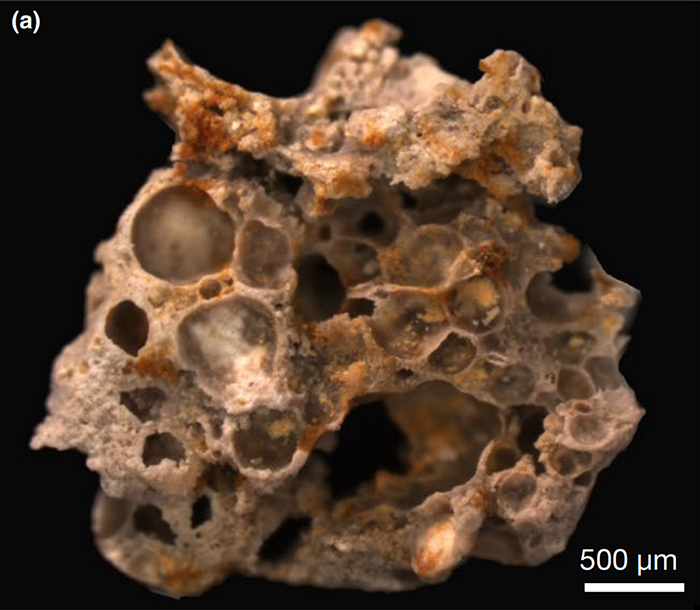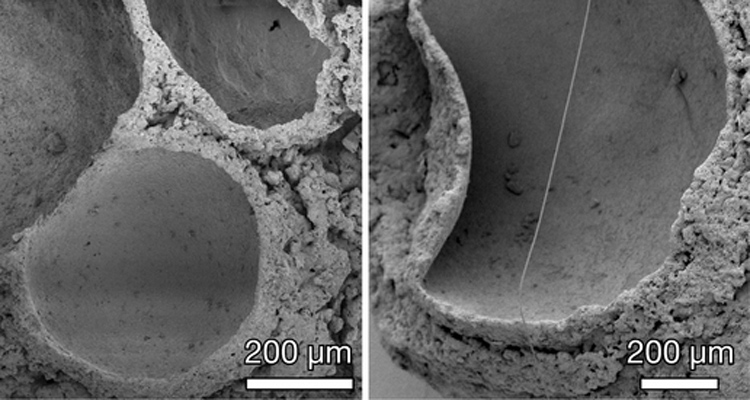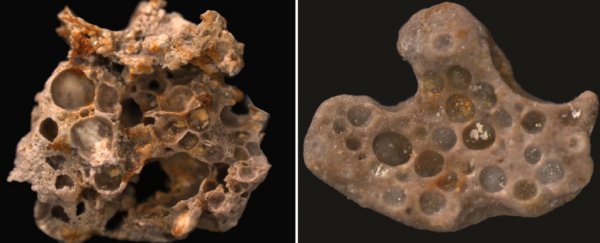It's not often you get chance to look at something that's several billion years old - we're totally amazed by these fossilised remains, found in rocks formed from microbial mats that settled in shallow pools some 1.6 billion years go.
The holes you see were formed by oxygen bubbles given off by tiny microbes, setting the foundations for life as our planet started to become increasingly hospitable.
That's according to a new study on the mats carried out by researchers in Sweden and Denmark, who describe their findings as "a signature for life". The billion-year-old material can teach us more about this distant period of history, say the researchers.
 (Stefan Bengtson)
(Stefan Bengtson)
Mats like the ones that formed these fossils are typically produced at the intersection of different substances – such as ocean water and the ocean floor – and are made up of the simplest of microorganisms, including bacteria.
In this particular case, the mats mined from central India are thought to show oxygen bubbles created by cyanobacteria, a particular type of bacterium that produces energy through photosynthesis.
As well as exhaling oxygen, cyanobacteria also excrete minerals, and this combination of oxygen and minerals would've been crucial in allowing other life on Earth to flourish.
This extra oxygen supply would've been seized upon by more advanced organisms, plants, and eventually animals, according to the researchers.
The tiny organisms produced even tinier bubbles: the ones you can see are only around 50-500 microns in size, so some are as small as the width of a human hair.
 Some bubbles have been partly compressed, suggesting a flexible original texture (Stefan Bengtson)
Some bubbles have been partly compressed, suggesting a flexible original texture (Stefan Bengtson)
But even at such a miniature size, these bubble fossils can help scientists understand more about how cyanobacteria worked and spread. They were taken from a thick sedimentary layer called the Vindhyan Supergroup, one of the most ancient records of early life we have.
"These evidences together point toward a shallow setting where primary production was dominated by cyanobacterial and algal photosynthesis," the team writes in their study.
The research has to be taken in the context of other studies, but ultimately can reveal more about the beginnings of life.
In particular, the way that a barren and rocky planet might have gradually evolved to become perfect for supporting life. Oxygen would have played a big part in that, and especially the Great Oxygenation Event that scientists reckon got underway around 2.45 billion years ago.
While increased oxygen levels would've killed off some microbes that evolved without oxygen, others would have been allowed to develop and flourish, marking the transition from the sparsely inhabitated landscape of Earth's middle age to the lush world we're familiar with today.
The team from the University of Southern Denmark, Stockholm University in Sweden, and the Swedish Museum of Natural History says these oxygen-producing cyanobacteria could have been crucial in producing the mineral rich phosphorite rocks that were formed from sediment over millions of years.
"This study suggests that oxygenic phototrophic biotas may have played a larger role in the construction of ancient shallow-water phosphorites than previously recognised," conclude the researchers.
The research has been published in Geobiology.
